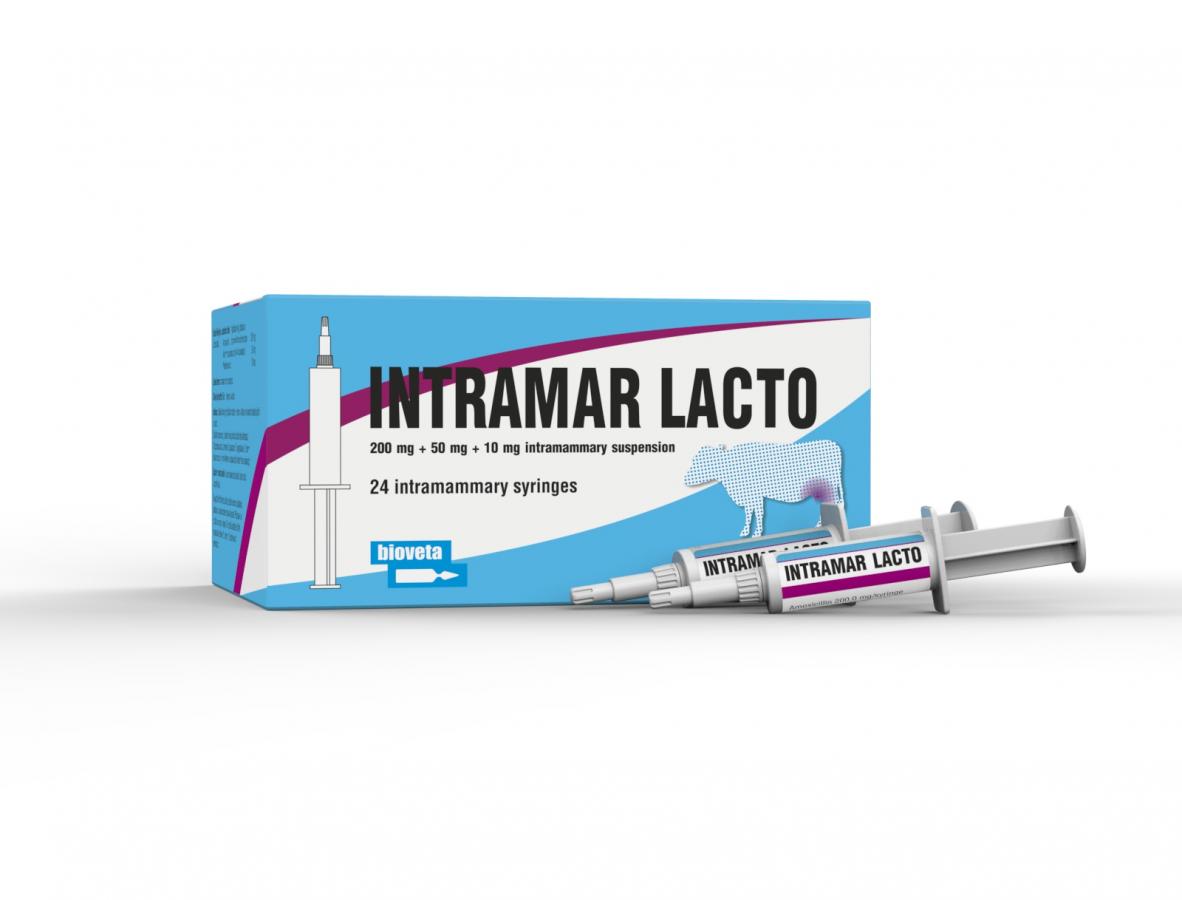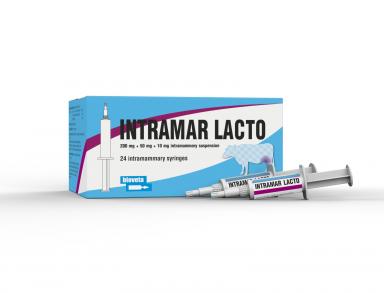NTRAMAR Lacto 200 mg + 50 mg + 10 mg intramammary suspension for cattle
Homepage Products Veterinary products NTRAMAR Lacto 200 mg + 50 mg + 10 mg intramammary suspension for cattle
Intramammary antibiotic for the treatment of mastitis containing potentiated Amoxicillin and Prednisolone.
| type of preparative: | Antimicrobial products |
|---|---|
| target species animals: | Cattle |
QUALITATIVE AND QUANTITATIVE COMPOSITION
Each intramammary syringe (3 g) contains:
Active substances:
Amoxicillin (as amoxicillin trihydrate) 200.0 mg
Clavulanic acid (as potassium clavulanate) 50.0 mg
Prednisolone 10.0 mg
Excipients:
|
Qualitative composition of excipients and other constituents |
|
Sodium aluminosilicate |
|
Cetostearyl alcohol (type B), emulsifying |
|
Paraffin, white soft |
|
Paraffin, light liquid |
Cream to yellow-brown oily intramammary suspension.
CLINICAL INFORMATION
Target species
Cattle (lactating cows).
Indications for use for each target species
For the treatment of clinical mastitis including cases associated with infections with the following pathogens:
Staphylococci (including b-lactamase producing strains)
Streptococci (including S. agalactiae, S. dysgalactiae and S. uberis)
Escherichia coli (including b-lactamase producing strains)
Contraindications
Do not use in cases of hypersensitivity to the active substance or to any of the excipients.
Do not use in animals which are known to be hypersensitive to b-lactam antibiotics.
Special warnings
Do not use in cases associated with Pseudomonas.
The veterinary medicinal product should be used for treatment of clinical mastitis only.
Avoid use of the veterinary medicinal product in herds where no β-lactamase producing Staphylococci strains have been isolated.
Cross-resistance has been shown between amoxicillin/clavulanic acid and b-lactam antibiotics. Use of the veterinary medicinal product should be carefully considered when susceptibility testing has shown resistance to b-lactam antibiotics because its effectiveness may be reduced.
Most ESBL and AmpC ß-lactamase-producing E. coli strains may not be inhibited by the combination of amoxicillin/clavulanic acid. The combination of amoxicillin and clavulanic acid is not effective against methicillin-resistant strains of S. aureus (MRSA).
Special precautions for use
Special precautions for safe use in the target species:
Use of the veterinary medicinal product should be based on identification and susceptibility testing of the target pathogen(s). If this is not possible, therapy should be based on epidemiological information and knowledge of susceptibility of the target pathogens at farm level, or at local/regional level.
Use of the veterinary medicinal product should be in accordance with official, national and regional antimicrobial policies.
An antibiotic with a lower risk of antimicrobial resistance selection (lower AMEG category)
should be used for first line treatment where susceptibility testing suggests the likely efficacy of this approach.
Narrow spectrum antibiotic therapy with a lower risk of antimicrobial resistance selection should be used for first line treatment where susceptibility testing suggests the likely efficacy of this approach.
The feeding of waste milk containing residues of amoxicillin and clavulanic acid to calves should be avoided up to the end of the milk withdrawal period (except during the colostral phase), because it could select antimicrobial-resistant bacteria within the intestinal microbiota of the calf and increase the faecal shedding of these bacteria.
Special precautions to be taken by the person administering the veterinary medicinal product to animals:
Penicillins and cephalosporins may cause hypersensitivity (allergy) following injection, inhalation, ingestion or skin contact. Hypersensitivity to penicillins may lead to cross-reactions to cephalosporins and vice versa. Allergic reactions to these substances may occasionally be serious.
People with known hypersensitivity to penicillins and/or cephalosporins should avoid contact with the veterinary medicinal product.
If you develop symptoms following exposure such as a skin rash, you should seek medical advice and show the package leaflet or the label to the physician. Swelling of the face, lips or eyes or difficulty breathing are serious symptoms and require urgent medical attention.
This veterinary medicinal product may cause irritation of skin and eyes. Avoid contact with skin and eyes. In case of contact with skin or eyes, flush the affected area with plenty of clean water.
The cleaning wipes supplied with the veterinary medicinal product contain isopropyl alcohol, which may cause skin or eye irritation in some people.
Personal protective equipment consisting of gloves should be used when handling the veterinary medicinal product and cleaning wipes.
Wash hands after use.
Special precautions for the protection of the environment:
Due to the endocrine-disrupting potential of prednisolone, the veterinary medicinal product may be dangerous to fish and other aquatic organisms. Consequently, treated animals should not have access to watercourses during the first 12 hours after treatment.
Adverse events
Cattle (lactating cows):
None known.
Reporting adverse events is important. It allows continuous safety monitoring of a veterinary medicinal product. Reports should be sent, preferably via a veterinarian, to either the marketing authorisation holder or its local representative or the national competent authority via the national reporting system. See the package leaflet for respective contact details.
Use during pregnancy, lactation or lay
Pregnancy and lactation:
Can be used during pregnancy and lactation.
Interaction with other medicinal products and other forms of interaction
None known.
Administration routes and dosage
Intramammary use.
Milk out the infected quarters. Before infusion, the teat end should be cleaned and disinfected with the enclosed disinfectant wipe or a cleaning towel and an appropriate disinfectant. The content of one syringe should be infused into each affected quarter via the teat canal, immediately after milking, at 12 hour intervals for three consecutive milkings. In cases of infections caused by Staphylococcus aureus, a longer course of antibacterial therapy may be required. Therefore, overall treatment length must be at the veterinarian’s discretion but should be long enough to ensure complete resolution of intramammary infection.
Symptoms of overdose (and where applicable, emergency procedures and antidotes)
No adverse reactions are to be expected from an accidental overdose.
Special restrictions for use and special conditions for use, including restrictions on the use of antimicrobial and antiparasitic veterinary medicinal products in order to limit the risk of development of resistance
Not applicable.
Withdrawal periods
Meat and offal: 7 days.
Milk: 84 hours.
PHARMACOLOGICAL INFORMATION
ATCvet code: QJ51RV01
Pharmacodynamics
Amoxicillin is a broad spectrum bactericidal b-lactam antibiotic. Clavulanic acid inactivates b-lactamases. This combination is effective against b-lactamase producing organisms, with exception of most ESBL and AmpC producing Gram-negative bacteria.
Prednisolone is an anti-inflammatory corticosteroid.
In vitro, clavulanic acid and amoxicillin in combination are active against a wide range of clinically important bacteria including the following organisms which are commonly associated with bovine mastitis:
Staphylococci (including b-lactamase producing strains, with exception of MRSA)
Streptococci (including S. agalactiae, S. dysgalactiae and S. uberis)
Escherichia coli (including b-lactamase producing strains, with exception of strains producing ESBLs and AmpC)
Table 1: Minimum inhibitory concentration - MIC90[mg/l] of amoxicillin/clavulanic acid for bacteria causing mastitis in dairy cattle in the Czech Republic (CZ) and Germany (DE)
|
|
E. coli |
S. aureus |
NAS* |
Str. uberis |
Str. dysgalactiae |
Str. agalactiae |
|
CZ (2020 - 2023) |
8 (n=368) |
- |
- |
1 (n=667) |
- |
- |
|
DE (2020 - 2021) |
16 (n=54) |
0.5 (n=180) |
0.5 (n=88) |
0.5 (n=158) |
0.03 (n=51) |
0.12 (n=28) |
NAS: non-aureus staphylococci
The mechanisms of resistance of bacteria to b-lactams include enzymatic degradation through production of b-lactamases, alteration of target proteins of the cell wall (PBP – penicillin binding proteins) and changes in expression of genes encoding efflux pumps. Acquired resistance can be linked with gene mutation or horizontally transferred via mobile genetic elements, e.g. plasmids. The production of β-lactamases is the most common resistance mechanism of gram-negative bacteria (e.g. ESBL, AmpC b-lactamase producing E. coli), on the other hand, alteration of PBP is mainly applied to gram-positive bacteria (methicillin-resistant strains of S. aureus, S. pseudintermedius). Depending on the underlying mechanism of resistance, cross-resistance to other b-lactam antibiotics and co-resistance to antimicrobials from other pharmacological groups may occur.
Pharmacokinetics
None known.
Environmental properties
Prednisolone has endocrine-disrupting potential and therefore may be dangerous to fish and other aquatic organisms.
PHARMACEUTICAL PARTICULARS
Major incompatibilities
Not applicable.
Shelf life
Shelf life of the veterinary medicinal product as packaged for sale: 18 months.
Shelf life after first opening the immediate packaging: use immediately.
Special precautions for storage
Do not store above 25 °C.
Store in a dry place.
Nature and composition of immediate packaging
A single dose 4.5 ml LDPE intramammary syringe equipped with a LDPE cap, a LDPE cuff and a LDPE plunger.
Package size:
Carton box of 24 syringes.
Carton box of 24 syringes and 24 disinfectant wipes moistened with 65% v/v isopropyl alcohol solution (2.4 ml/wipe) to clean teats.
Not all pack sizes may be marketed.
Special precautions for the disposal of unused veterinary medicinal products or waste materials derived from the use of such products
Medicines should not be disposed of via wastewater or household waste.
The veterinary medicinal product should not enter water courses as prednisolone may be dangerous for fish and other aquatic organisms.
Use take-back schemes for the disposal of any unused veterinary medicinal product or waste materials derived thereof in accordance with local requirements and with any national collection systems applicable to the veterinary medicinal product concerned.










